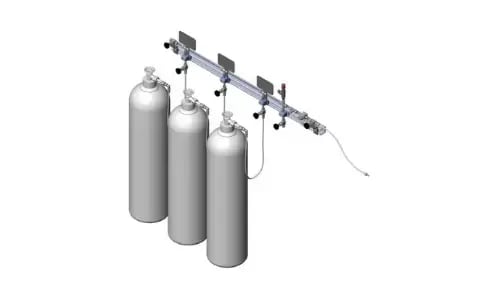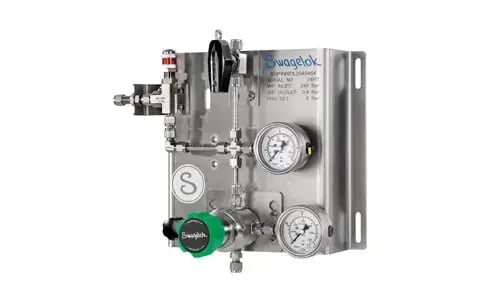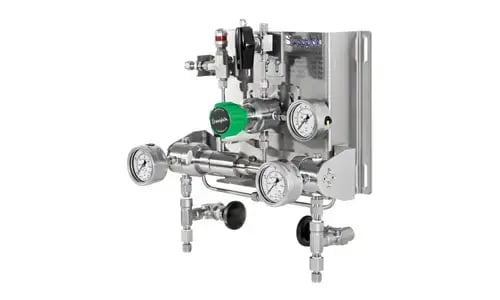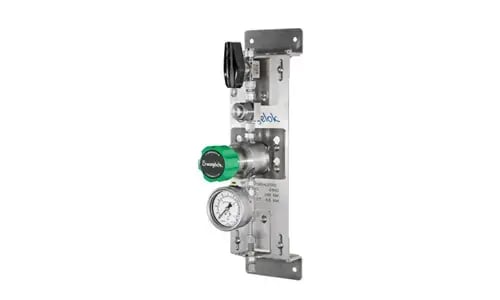Optimizing Gas Distribution Systems for Safety and Cost Efficiency
Gas distribution systems: efficient, safe and cost effective
Gas distribution systems are often considered a utility. Like a plant's electrical grid, it is often assumed that a gas distribution system will always work properly. Because these systems occur throughout the plant, no single department has exclusive responsibility for system optimization. For plant managers, other pressing operational issues usually take priority.
What is a gas distribution system?
A gas distribution system consists of a network of pipes, regulators and other components that transport gas from its source to a desired user point. Often, gas distribution systems have several purposes:
Access point to gas supply
Gas distribution systems create a connection between the gas source and the user point so that users have access to the gas they need.
Source pressure reduction
They reduce the high pressure of gas from the source to a stable and controllable pressure for various applications.
Gas supply without interruption
Gas distribution systems provide a continuous supply of gases, which is essential for critical processes.
Transport of various types of gases
These systems can handle reactive, toxic, corrosive or high-value gases, depending on the specific requirements.
Risks associated with gas distribution systems
Poorly functioning gas distribution systems pose risks. Examples include:
-
Worker safety: Gases that escape can cause injuries to nearby workers, even if the gas itself is not dangerous.
-
Equipment damage:
Excessive pressure can cause damage to equipment, resulting in process downtime and the need for costly repairs or replacements. -
Hazardous gases:
In cases where the system transports hazardous, toxic or flammable gases, any undetected leak can pose a significant risk to both workers and equipment.
Cost considerations
Even small gas leaks that seem harmless can eventually lead to significant costs. For example:
- Unidentified leaks of nitrogen (costs an average of a few cents in euros perm3) resulting in tens of thousands of dollars in losses per year.
- Leaks of more expensive gases, such as helium (with prices of tens of euros perm3), can increase costs even faster.
At a leading chemical company, Swagelok discovered opportunities to unify the design of gas panels.
Important subsystems for gas distribution systems
A primary function of gas distribution systems is to reduce pressure from a supply source and deliver gas at a stable pressure to a user point with minimal interruption. This can be achieved by building gas distribution systems with four main subsystems:

Swagelok Source Inlet (SSI)
- Safe replacement of gas cylinders with purge and venting options.
- Connection between source and distribution system.
The source inlet connects the high-pressure gas source and the distribution system. It is important that the inlet is built with appropriate cylinder connections, hoses, tubing, filters and venting, flushing and relief functions to ensure that gas can be safely fed to the primary gas pressure control or automatic changeover. For a single gas cylinder, the assembly may be as simple as a hose and connector. Multiple cylinders may require a manifold with many hoses and valves.

Swagelok Gas Panel (SGP)
- Initial pressure reduction of source gas.
- Modular design, easy to maintain.
As the primary gas pressure control, the SGP completes the initial pressure drop of the source gas and ensures it is delivered to the next stage of the system at the proper flow rate. Pressure reduction is achieved in one stage with a single pressure regulator or in two stages through a dual pressure regulator arrangement.

Swagelok Changeover (SCO)
- Automatic switching between sources.
- Continuity and less waste.
The automatic changeover system switches seamlessly from one gas source to another to ensure an uninterrupted supply. This is achieved through staggered set points of two pressure regulators, allowing the system to continue operating while the primary gas source is changed. Our switching station allows for customized switching set points to reduce wasted gas in cylinders.

Swagelok Point of Use (SPU)
- Local pressure control for workstations or equipment.
- Compact, accurate, standardizable.
The point-of-use system provides the critical final stage of pressure control before gas is used. These are often the least complex of the four main systems, usually involving a pressure regulator, pressure gauge and shut-off valve. Usage point systems offer operators and technicians a convenient and accurate method of adjusting pressure to suit their test bench or equipment needs.
TechTalk Gasdistributie
 A half-hour technical presentation. In this video, an expert shares their knowledge on a specific topic, with numerous practical examples, applications, and advice.
A half-hour technical presentation. In this video, an expert shares their knowledge on a specific topic, with numerous practical examples, applications, and advice.
Design and assembly of gas distribution systems.
Correct component selection, solid design and assembly, and ongoing maintenance are essential to the long-term reliability of gas distribution systems.
Component selection
Improper component selection is a common cause of unsafe or costly gas systems. Because there are a wide range of general industrial fittings, valves, regulators and other components available on the market, it can be difficult to make the right selections.
For example, choosing the right pressure regulator depends on a few key characteristics. The right regulator will:
- Be able to handle the pressures of your system
- Provide the proper flow capacity (Cv) to meet your needs at the point of use
- Be made of compatible materials that will not corrode or otherwise degrade during regular use (which applies to all components in the system)
System design
Thoughtful system design is also critical to ensure that all components work together to ensure optimal system efficiency and safety. Ideally, your subsystems should contain as few threaded connections as possible to minimize the risk of leaks. In addition, it is recommended that you choose a design that is user-friendly and allows for easy maintenance. Gas panels with clearly marked controls can simplify operation and reduce the risk of user error.
In addition to individual subsystems, it is essential that the overall system design be tailored to the specific goals and needs of your gas distribution system. This is true during the construction of new systems or when modifying existing ones. Making consistent, thoughtful choices when it comes to design, component selection and can contribute to an even safer and more efficient system.
Assembly and installation
 Errors during system assembly and installation can lead to undesirable safety consequences. Improper assembly combined with insufficient testing prior to pressurization can affect not only the long-term performance of the system, but also the safety of operators and bystanders. Lack of training on gas and fluid systems is a major cause of assembly and installation problems.
Errors during system assembly and installation can lead to undesirable safety consequences. Improper assembly combined with insufficient testing prior to pressurization can affect not only the long-term performance of the system, but also the safety of operators and bystanders. Lack of training on gas and fluid systems is a major cause of assembly and installation problems.
Once installation is complete, it is important that operators are also properly trained to use and maintain the systems.
Maintenance
Gas panels that are easier to maintain obviously give a time advantage. Panels designed with essential components such as regulators on the front, rather than on the back, can make them easier to access when filter changes or other maintenance tasks are required.
Better accessibility to controllers can lead to:
Time savings of 30 minutes to 2 hours, depending on circumstances
Cost savings of thousands of dollars
Expertise
If you need help designing, building and assembling new gas distribution systems or evaluating existing systems, gas and fluid systems specialists can help. Choosing pre-designed, fully tested, standardized subsystems that are available will also minimize your techs' time. Suppliers can also add features or make modifications to meet your requirements.
An outside evaluation can help identify opportunities for system improvements, inform controller selection, and guide the design and assembly of engineering solutions. An expert familiar with specific gas delivery challenges can also offer suggestions for how existing systems can be modified to meet new requirements.
Although often overlooked, gas delivery is a critical component of the safe, efficient and economical operation of your facility. Therefore, your gas distribution system deserves careful attention.
Contact one of our gas distribution experts directly
You May Also Like
These Related Articles

How to Manage the Supply Pressure Effect in Industrial Gas Regulators

Troubleshooting Common Pressure Regulator Problems in Systems
